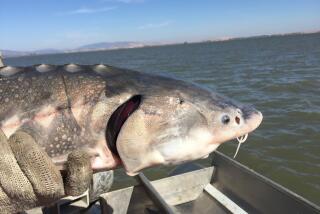Lake Michigan has become dramatically clearer in last 20 years — but at a steep cost
Decades ago, Lake Michigan teemed with nutrients and green algae, casting a brownish-green hue that resembled the mouth of an inland river rather than a vast, open-water lake.
Back then, the lake’s swampy complexion was less than inviting to swimmers and kayakers, but it supported a robust fishing industry as several commercial companies trawled for perch and sport fishermen cast their lines for trout. But in the last 20 years, Lake Michigan has undergone a dramatic transformation.
In analyzing satellite images between 1998 and 2012, researchers at the Michigan Tech Research Institute were surprised to find that lakes Michigan and Huron are now clearer than Lake Superior. In a study published late last year, the researchers say limiting the amount of agricultural and sewage runoff in the lake has had an immense impact. However, the emergence of invasive mussels, which number in the trillions and have the ability to filter the entire volume of Lake Michigan in four to six days, has had an even greater effect.
“When you look at the scientific terms, we are approaching some oceanic values,” said Michael Sayers, a research engineer at Michigan Tech and coauthor of the study. “We have some ways to go, but we are getting a lot closer to Lake Tahoe. A lot of times, you’ll hear from people that the water is so blue it compares to something in tropical areas.”
While appealing, the clarity comes at a significant cost to wildlife. In filtering the lake, the mussels have decimated the phytoplankton, a single-celled, green algae that serves as the base of the food chain. For much of the last decade, prey fish, like alewives, have remained at historical lows, prompting state managers to scale back the annual stocks of prized predators, such as king salmon.

The startling evolution has called into question the future of Great Lakes marine life and the region’s $7-billion fishing industry.
“Clearer is not necessarily better,” said Robert Shuchman, co-director of the Michigan Tech Research Institute. “Clearer water means less phytoplankton in the water column, and they’re the basic building block in the food web. The idea is, the little fish eat algae, and the bigger fish eat the little fish.
“There are some folks out there now that think Lake Michigan and Huron could become ecological deserts from a fishing standpoint. The food web could totally collapse because you don’t have the various organisms you need to sustain it.”
For ages, the phytoplankton fed the zooplankton, which were eaten by small, foraging fish. As the fast-filtering mussels reduce the plankton populations, there isn’t enough food to support the diet of many foraging fish. In addition, there’s not enough plankton or nutrients clouding the water to hide these small prey fish from predator fish.
“It’s a game of hide-and-seek in a brightly lit environment,” said Henry Vanderploeg, a research ecologist for the National Oceanic and Atmospheric Administration.

After years of working aboard a relative’s charter boat, Rick Bentley was leaving the fishing industry in the early ’90s to pursue a career in finance when the mussels began arriving.
“A lot of people were sounding massive alarms about how the mussels could change everything,” recalled Bentley, 46.
Their fears turned out to be prophetic. As the water cleared up, the fish cleared out. Since the introduction of the mussels in the 1980s, which arrived via ships’ ballast water, there’s been a sharp decline in nearly all fish species in Lake Michigan, including king salmon, scientists say.
At the height of king salmon fishing in the mid- to late ’80s, about 10 million pounds of the fish were harvested from the lake each year, according to research by the U.S. Fish and Wildlife Service and agencies from four states. In recent years, fishermen are managing to nab only about 3 million pounds.
King salmon are low-light-feeding fish, so with sunlight reaching into lower depths, it’s become increasingly difficult to catch them during midday hours, Bentley said. He’s found fishing at dawn and sundown provides the best chance to catch salmon.
The clearer waters have made flashers and dodgers, devices that reflect light and attract fish, more effective tools, Bentley said. Still, remaining undetected is a challenge.
“Generally, fish are more likely to keep their distance because they can see the boat and gear now,” he said.
Over the years, the Great Lakes have endured numerous encounters with invasive species. The mussels may be the worst Lake Michigan has seen since the sea lamprey, an eel-like parasitic fish that slithered into the Upper Great Lakes in the 1940s through the Erie and Welland canals, according to David “Bo” Bunnell, a research fishery biologist at the U.S. Geological Survey’s Great Lakes Science Center. Sea lampreys latched onto large fish and drained their blood, leading to a collapse in populations of native predators like lake trout.
“They pretty much devastated native lake trout, lake whitefish and other native species that were already suffering from overfishing,” Bunnell said. “That was the one-two death punch.”
The arrival of zebra and quagga mussels led to the collapse of alewives and king salmon in Lake Huron in the early 2000s. Scientists say the crash in alewives stemmed from less food availability and more predation by the king salmon, which was stocked by the Michigan Department of Natural Resources and naturally reproducing. The king salmon diet is almost exclusively made up of alewives.
The Lake Huron king salmon, emaciated as their favorite prey became harder to find, migrated to Lake Michigan in search of alewives.
Nearly two decades later, the same progression is underway in Lake Michigan.
There is, however, a sliver of hope. Scientists say the invasive mussels may have reached their limits. With less plankton, the concentration of mussels in Lake Michigan dropped 40% between 2010 and 2015, according to a yet-to-be published report by Buffalo State College’s Great Lakes Center. But the total weight of mussels in the lake has risen, suggesting the surviving mussels are growing larger, said Alexander Karatayev, the center’s director. It’s unclear what this might mean in the future.
“However, it is extremely important to keep monitoring the [quagga mussel] population to understand if this decline is a long-term trend and if the population eventually will stabilize or will fluctuate substantially,” Karatayev said.
For now, better fisheries management has helped Lake Michigan see a return of lake trout. The sport has changed for fishermen like Bentley, but he said there’s always been something biting on the end of his line.
Last year was the best in several years, he said. Though king salmon catches remained low, many of the fish from yesteryear, like lake trout, seem to be returning.
“We’ve seen Lake Michigan go through a lot of changes, but it all seems to work out and it always ends up being OK,” Bentley said. “Last two years, I’ve been encouraged by the comeback. I don’t think we’ll ever see the heyday of king salmon, but I think they’ll always be available.”
More to Read
Sign up for Essential California
The most important California stories and recommendations in your inbox every morning.
You may occasionally receive promotional content from the Los Angeles Times.










